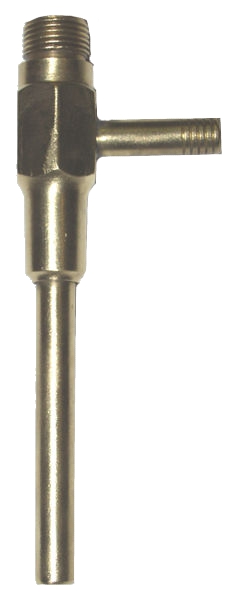Organization:Aspirator (pump)
 A brass aspirator. The water inlet and outlet are at the top and bottom, respectively; the air inlet is on the side. | |
| Other names | Eductor-jet pump, injector/ejector, filter pump, Venturi pump |
|---|---|
| Uses | Vacuum generation, suction |
| Related items | Injector, vacuum pump |
An aspirator is a type of ejector-jet pump, which produces vacuum by means of the Venturi effect.
In an aspirator, fluid (liquid or gaseous) flows through a tube that first narrows and then expands in cross-sectional area. When the tube narrows, the fluid pressure decreases. In this narrow area the fluid velocity must increase to conserve mass continuity. Where the tube narrows, a vacuum is drawn because of the Venturi effect.
Operation
The cheap and simple water aspirator is the most common type of aspirator. It is used in chemistry and biology laboratories and consists of a tee fitting attached to a tap and has a hose barb at one side. The flow of water passes through the straight portion of the tee, which has a restriction at the intersection, where the hose barb is attached. The vacuum hose should be connected to this barb. In the past, water aspirators were common for low-strength vacuums in chemistry benchwork. However, they are water-intensive, and depending on what the vacuum is being used for (i.e. solvent removal), they can violate environmental protection laws such as the RCRA by mixing potentially hazardous chemicals into the water stream, then flushing them down a drain that often leads directly to the municipal sewer.
If a liquid is used as the working fluid, the strength of the vacuum produced is limited by the vapor pressure of the liquid (for water, 3.2 kPa or 0.46 psi or 32 mbar at 25 °C or 77 °F). If a gas is used, however, this restriction does not exist. The industrial steam ejector (also called the "steam jet ejector", "steam aspirator", or "steam jet aspirator") uses steam as a working fluid.
In order to avoid using too much steam, a single steam-ejector stage is generally not used to generate vacuum below approximately 10 kPa (75 mmHg).[1] To generate higher vacuum, multiple stages are used; in a two-stage steam ejector, for example, the second stage provides vacuum for the waste steam output by the first stage. Condensers may be used between stages to reduce the load on the later stages. Steam ejectors with two, three, four, five and six stages may be used to produce vacuums down to 2.5 kPa, 300 Pa, 40 Pa, 4 Pa, and 0.4 Pa, respectively.[1]
The air ejector or Venturi pump is similar to the steam ejector but uses high-pressure air as the working fluid. They are called vacuum ejectors and they generate vacuum by changing the pressure of the compressed air. Multistage air ejectors can be used, but since air cannot easily be condensed at room temperature, an air ejector is usually limited to two stages.
See also
- Diffusion pump
- Injector
- Vacuum pump
- Water eductor
References

